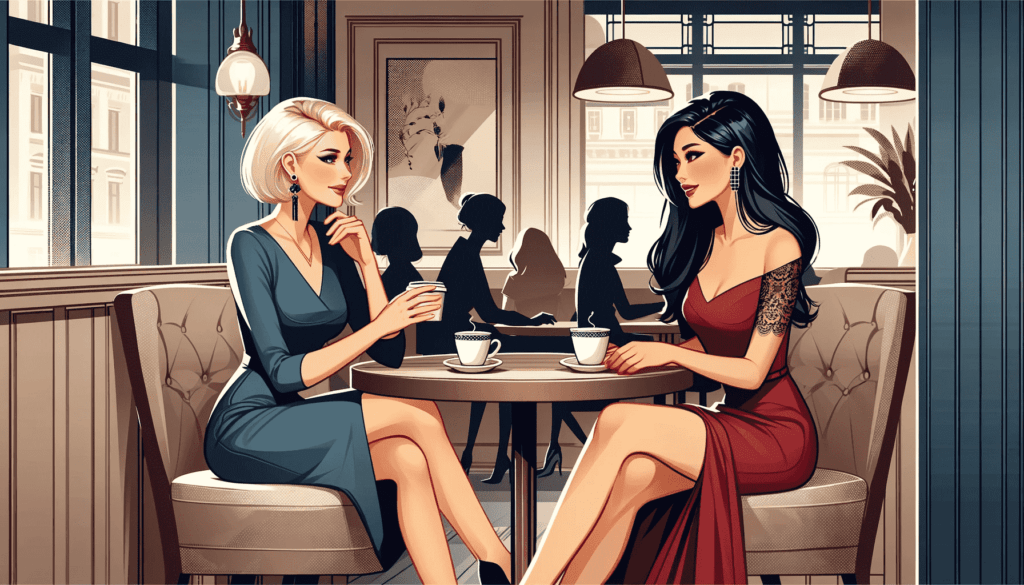In the world of body language, every little detail matters. The way we sit, including how we cross our legs, can reveal a lot about our state of mind.
While it might seem like a small thing, the position of our legs while sitting can actually tell a story about what’s going on inside us.
Whether you’re in a business meeting, a casual gathering, or simply lounging at home, the way you cross your legs can send messages you might not even be aware of.
It’s fascinating how such a habitual action can hold so much meaning.
This article delves into the various interpretations of crossed legs in body language, exploring what different positions might mean in different contexts.
Key Takeaways:
- Crossed legs can indicate comfort and relaxation, often showing that a person is at ease in their current environment.
- A defensive or protective stance is also communicated through crossed legs, creating a physical barrier in uncomfortable situations.
- In many cultures, crossing legs is a sign of respect and formality, especially in professional or formal settings.
- The gesture of crossing legs can be a simple habit or personal style, not always having a deep psychological meaning.
[Read: What Does Body Language Mean?]
Crossed Legs Body Language: 8 Things It Means
Crossed legs can often be a subtle yet profound indicator of a person’s mindset and emotional state. Let’s dive into what it means when you see someone sitting with their legs crossed.
1. Comfort and Self-Relaxation
When someone crosses their legs, it can be a sign of comfort and self-relaxation. This position often indicates that the person feels at ease in their environment.
Think about how you sit when you’re lounging at home; crossing your legs is a way to settle in and create a sense of personal space.
But there’s more to it. This posture can also be a self-soothing gesture.
During moments of mild stress or contemplation, people might cross their legs to subconsciously comfort themselves.
Additionally, in social settings, this pose might suggest that the person is content and not seeking to dominate the conversation. They’re participating, yes, but in a laid-back manner.
It reflects a balance of engagement and personal comfort, showing they’re part of the group but also in their own comfortable bubble.
2. Defensive or Protective Stance
On the flip side, crossed legs can sometimes signal a defensive or protective stance. This is particularly true in unfamiliar or uncomfortable settings.
When someone crosses their legs, they’re creating a physical barrier, which can be a non-verbal way of saying, “I need some space.”
Think about a tense meeting or a challenging social situation. In these scenarios, crossed legs could be a subconscious effort to shield oneself from perceived emotional or psychological threats.
It’s a natural human response to try and protect our vulnerable areas.
Moreover, this posture can also indicate that the person is not entirely open to the ideas or opinions being presented.
They’re present physically but may be holding back their full engagement or agreement.
3. A Sign of Formality

In many cultures, crossing legs is seen as a sign of formality. It’s often perceived as a polite way to sit, especially in professional or formal settings.
This posture can convey a sense of propriety and poise, showing that the person is mindful of their manners.
In a business meeting or a formal dinner, for instance, crossing legs can reflect a person’s awareness of decorum.
It shows they’re not just physically present, but also attuned to the social norms and expectations of the setting.
This pose also communicates a degree of self-awareness and control. By sitting in a manner that’s considered culturally respectful, the individual demonstrates their understanding of social etiquette.
[Interesting: What Does It Mean When A Guy Pats You On The Head?]
4. Personal Style or Habit
Sometimes, the reason behind crossed legs is as simple as personal style or habit. For many, it’s just a comfortable way to sit.
It might not have any deep psychological or emotional implications at all.
People often develop certain postures that they find most comfortable over time. These can become ingrained habits, done without much thought.
In these cases, trying to read too much into the body language might lead us astray.
Moreover, personal style plays a role. Some people might cross their legs because they feel it looks more elegant or composed.
It’s a part of their personal brand, a way they present themselves to the world. So, in these instances, it’s less about the subconscious and more about conscious self-presentation.
5. Indication of Boredom or Impatience
Ever noticed how people often cross their legs when they seem a bit bored or impatient? This gesture can be a subtle indicator of their desire to leave or move on from the current situation.
This isn’t just about being rude or disinterested, though. Sometimes, it’s more about feeling restless in a situation that isn’t stimulating enough.
The act of crossing and uncrossing legs, especially if done repeatedly, can be a physical manifestation of an internal desire for a change of pace or scenery.
However, it’s important not to jump to conclusions. Someone might just be finding a more comfortable sitting position.
But if you notice this behavior along with other signs of restlessness, like frequent glances at a watch or a phone, it could very well signal boredom or impatience.
6. Subconscious Mimicking
Body language can be quite contagious! If you’re in a group and someone crosses their legs, don’t be surprised if others, including yourself, start doing the same.
This phenomenon, known as mirroring, is a subconscious way of building rapport and showing empathy towards others.
Mirroring happens without much thought. It’s a natural human tendency to mimic the body language of those we’re interacting with, especially if we feel a connection or want to establish one.
So, when someone crosses their legs, and you find yourself doing the same, it’s like your body’s way of saying, “I’m in tune with you.”
This behavior also plays a crucial role in non-verbal communication. It can create a sense of harmony and understanding within a group, making interactions smoother and more enjoyable.
[Related: Understanding The Crossed Arms Body Language]
7. Physical Comfort or Health Reasons
Sometimes, the reason for crossing legs is purely physical. It might be more comfortable for some, especially if they’ve been sitting in one position for a long time.
Changing leg positions can relieve muscle tension or discomfort.
For others, it might be a health-related habit. People with certain leg or back issues find that crossing their legs provides necessary support or relieves pressure.
It’s their body’s way of finding a position that minimizes discomfort or pain.
8. A Sign of Confidence or Self-Assuredness
Crossing legs can also be a display of confidence and self-assuredness.
When someone sits with their legs crossed, particularly in a figure-four position (where one ankle rests on the opposite knee), it often conveys a sense of self-confidence and relaxation in their own skin.
Such posture can take up more space than sitting with legs uncrossed, which in itself can be a display of confidence.
This can be particularly striking in a professional or formal setting, where taking up space is often unconsciously linked to higher status or self-esteem.
But again, context is key. This gesture might come across differently in various cultural or social settings.
What’s seen as a confidence move in one place might be perceived as too casual or even disrespectful in another. It all boils down to understanding the nuances of body language within different contexts.
[Also Read: 8 Body Language Signs A Guy Is Into You]
Understanding Crossed Legs Body Language For Women
Crossed legs for women in body language can often be linked to a sense of modesty, especially in cultures where this is emphasized.
In many social and professional settings, women might cross their legs to maintain a certain level of decorum.
It’s a posture that aligns with traditional ideas of femininity and propriety, showing respect for the social norms of the environment.
However, this doesn’t mean that every time a woman crosses her legs, it’s about modesty. It’s also a comfortable sitting position for many.
In relaxed settings, like hanging out with friends or lounging at home, crossing legs can simply be about finding a cozy posture.
It’s important to remember that while body language can tell us a lot, it’s not a one-size-fits-all indicator of someone’s intentions or feelings.
Moreover, crossed legs can also indicate a woman’s confidence, especially in professional environments.
When paired with an upright posture and engaged demeanor, it can be a powerful stance. It shows that a woman is not only aware of social conventions but also feels secure and poised in her surroundings.
Understanding Crossed Legs Body Language For Men

For men, crossed legs in body language can signify several things. In a professional setting, a man crossing his legs might be a sign of comfort and ease.
It’s a way of settling into a conversation or a meeting, indicating that he’s engaged but relaxed.
This posture can be seen as a blend of approachability and professionalism, showing that he’s part of the discussion but also at ease in his role.
In more casual settings, when a man crosses his legs, it might just be about finding a comfortable position. It’s not always a deeply meaningful gesture; sometimes, it’s just about physical comfort.
Men, like women, have their own preferences for how they sit, and this can change depending on the context and how long they’ve been in one position.
Interestingly, crossed legs for men can sometimes be interpreted as a defensive or closed-off posture, especially if the body is angled away from others.
If a man crosses his legs and turns slightly away, it might suggest he’s not fully open to the conversation or is feeling somewhat reserved.
However, this isn’t a hard and fast rule and should be considered in the context of other non-verbal cues and the environment.


